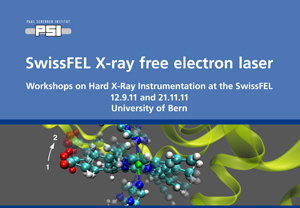Speaker
Artem Rudenko
(Max Planck Advanced Study Group at CFEL)
Description
During the last decade the rapid development of ultra-intense short-pulsed accelerator-based coherent X-ray light sources, Free-Electron Lasers (FEL), opened up a wide range of promising applications in physics, chemistry, biology and material sciences, in particular, paving the way towards imaging experiments with atomic spatial and fs temporal resolution. In order to enable these kind of studies, and to meet the requirements set by rapidly evolving interdisciplinary environment at FEL facilities, the Max Planck Advanced Study Group (ASG) at the Centre for Free Electron Laser Science (CFEL) has developed a multi-purpose experimental end station (CFEL-ASG Multi-Purpose chamber – CAMP) aimed at simultaneous (coincident) detection of ions, electrons, and (scattered or fluorescent) photons produced by the interaction of the FEL radiation with a large variety of targets (atoms, molecules, clusters, bio- and nano-particles, nano-crystas, solid-state samples etc.) [1].
The CAMP instrument is designed to host two unique large-area energy-resolving fast readout pnCCD detectors (developed by the Max Planck Semiconductor Laboratory) in combination with advanced many-particle electron and ion imaging systems (“reaction microscope” or double-sided velocity map imaging (VMI) spectrometers). After the commissioning of the first set of CAMP pnCCD detectors at the Free-electron LASer at Hamburg (FLASH) in August 2009, the whole machine was successfully installed at the Linac Coherent Light Source (LCLS) at Stanford, and hosted more than 20 user experiments during the first two years of LCLS operation, including, among others, multi-parameter studies on multiple ionization of atoms [2], photoelectron spectroscopy from laser-aligned molecules, (time-resolved) single-shot measurements on single clusters, coherent diffractive imaging of nano-crystals [3] and gas-phase viruses [4], nano-scale morphometry and mass spectrometry of aerosols [5], experiments with solid-state targets [6] etc.
With its leading-edge photon detectors, unique capabilities for multi-coincident measurements, and being adapted to host many of the sample delivery systems currently used or being developed within the active FEL community, this type of end station offers a variety of exciting experimental possibilities at different XFEL facilities. Currently a copy of this setup is being commissioned at the Spring 8 Angstrom Compact free-electron LAser (SACLA) in Japan, whereas the original CAMP apparatus is planned to be permanently installed at FLASH after it will be replaced by the slightly modified LAMP (LCLS-ASG Multi-Purpose) instrument at LCLS. Similar multi-parameter end station, as well as its individual components might become a valuable complementation for the user instrumentation at the upcoming SwissFEL.
[1] L. Strüder et al., Nucl. Instr. Meth. 614 483 (2010).
[2] B. Rudek et al., Nature Physics, submitted
[3] H.N. Chapman et al., Nature 470 73 (2011).
[4] M.M. Seibert et. al., Nature 470 78 (2011).
[5] N.D. Loh et. al., Science, submitted.
[6] S. Hau-Riege et al., Nature Materials, submitted
Author
Artem Rudenko
(Max Planck Advanced Study Group at CFEL)
Co-authors
Benedikt Rudek
(Max Planck Advanced Study Group at CFEL)
Benjamin Erk
(Max Planck Advanced Study Group at CFEL)
Daniel Rolles
(Max Planck Advanced Study Group at CFEL)
Faton Krasniqi
(Max Planck Advanced Study Group at CFEL)
Ilme Schlichting
(Max Planck Institute for Medical Research)
Joachim Ullrich
(Max Planck Institute for Nuclear Physics)
Lothar Strüder
(Max Planck Semiconductor Laboratory)
Lutz Foucar
(Max Planck Advanced Study Group at CFEL)
Robert Hartmann
(PN Sensor GmbH)
Sascha Epp
(Max Planck Advanced Study Group at CFEL)

